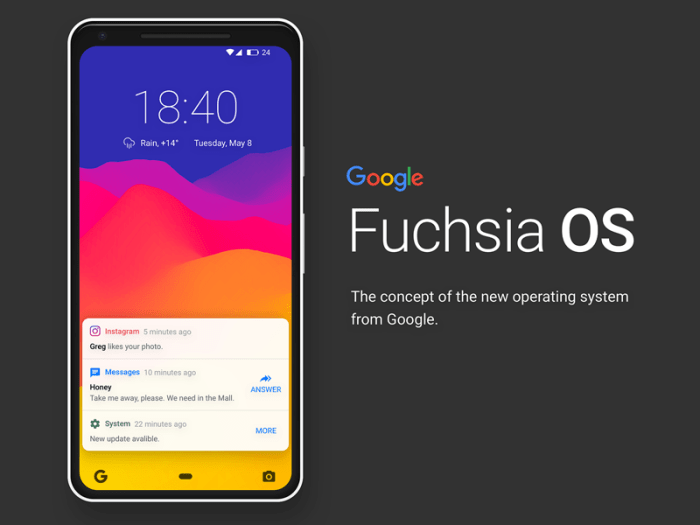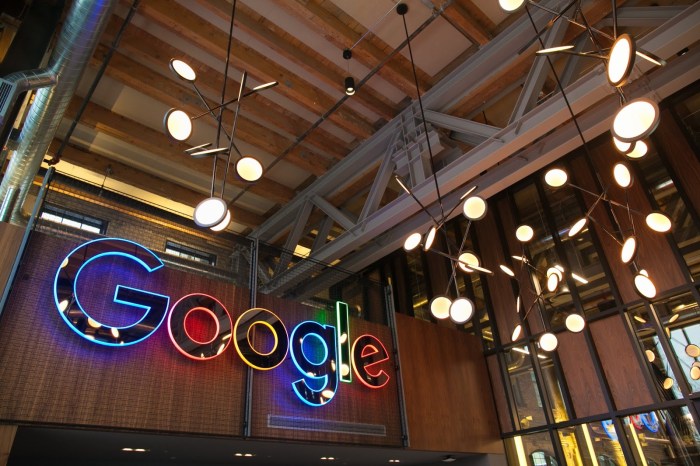Fuchsia OS
Google, the tech giant known for its innovative products and services, has embarked on a new journey by developing its own operating system called Fuchsia OS. While Android and Chrome OS have established their presence in the tech world, Fuchsia OS represents a fresh start, aiming to bring a new wave of functionality and user experience to the table.
Fuchsia OS: Key Features and Functionalities
Fuchsia OS is designed to be a modern, secure, and versatile operating system, capable of running on a wide range of devices, from smartphones and tablets to laptops and even embedded systems. It leverages a microkernel architecture, offering a robust and secure foundation for the operating system. This architecture allows Fuchsia OS to be modular and scalable, making it adaptable to different hardware configurations and device types.
Fuchsia OS is built on the Zircon microkernel, which is a secure and efficient foundation for the operating system. It provides a strong separation between the kernel and user space, enhancing security and stability. Zircon also features a modern memory management system, which optimizes memory usage and improves performance.
The user interface of Fuchsia OS is built on Flutter, a cross-platform UI toolkit developed by Google. Flutter enables the creation of visually appealing and performant user interfaces, offering a consistent experience across different devices. It also allows developers to write code once and deploy it across multiple platforms, reducing development time and effort.
Comparing Fuchsia OS with Existing Google Operating Systems
Fuchsia OS presents a distinct approach compared to Google’s existing operating systems, Android and Chrome OS. While Android has become the dominant mobile operating system, and Chrome OS has gained traction in the education and enterprise sectors, Fuchsia OS aims to provide a more unified and future-proof platform.
Android
- Android is primarily designed for mobile devices, such as smartphones and tablets.
- It is based on a Linux kernel and has a wide range of applications available.
- Android is known for its customization options and open-source nature.
Chrome OS
- Chrome OS is designed for laptops and Chromebooks, emphasizing web-based applications and cloud integration.
- It is built on the Linux kernel and utilizes the Chrome browser as its primary user interface.
- Chrome OS is known for its simplicity and ease of use.
Fuchsia OS
- Fuchsia OS is designed to be a universal operating system, capable of running on a wide range of devices.
- It is built on a microkernel architecture, offering a more secure and efficient foundation.
- Fuchsia OS utilizes Flutter for its user interface, providing a modern and consistent experience across devices.
Fuchsia OS’s versatility and potential to unify different device experiences make it a compelling alternative to existing operating systems. However, its adoption remains uncertain, as it is still in development and has not yet been widely released. Nevertheless, the potential of Fuchsia OS to revolutionize the way we interact with technology is undeniable.
Technical Architecture and Core Components
Fuchsia OS, Google’s ambitious new operating system, boasts a modern and modular architecture designed for flexibility and scalability. Its core components work together seamlessly to deliver a robust and secure platform for a variety of devices.
Zircon Microkernel
The foundation of Fuchsia OS is its microkernel, named Zircon. This lightweight kernel provides essential services like memory management, process scheduling, and inter-process communication. Its minimalist design emphasizes security and efficiency.
Zircon’s key role is to act as a secure and isolated foundation for the rest of the operating system.
- Security: Zircon’s microkernel architecture minimizes the attack surface by isolating system components, making it difficult for vulnerabilities in one component to compromise the entire system.
- Efficiency: By handling only essential functions, Zircon keeps its footprint small and optimizes system performance.
- Flexibility: The microkernel design allows Fuchsia OS to adapt to different hardware platforms and device types.
System Services
Built on top of Zircon, Fuchsia OS features a set of system services that provide core functionality for applications. These services are responsible for tasks like networking, storage, graphics, and security.
- Networking: Fuchsia OS utilizes a modern networking stack that supports various protocols, including IPv4, IPv6, and Wi-Fi.
- Storage: The operating system offers a flexible storage framework that can manage different types of storage devices, including internal storage and external drives.
- Graphics: Fuchsia OS leverages a graphics stack based on Vulkan, a modern graphics API, for efficient and high-performance rendering.
- Security: Fuchsia OS incorporates robust security mechanisms, including sandboxing and access control, to protect user data and applications.
Flutter User Interface
Fuchsia OS utilizes Flutter, Google’s cross-platform UI toolkit, to build its user interface. Flutter allows developers to create visually appealing and performant applications that run seamlessly across different devices.
- Cross-platform: Flutter’s codebase can be used to build applications for a wide range of devices, including smartphones, tablets, and even embedded systems.
- Performance: Flutter’s rendering engine is highly optimized for smooth animations and fast frame rates, delivering a responsive user experience.
- Declarative UI: Flutter uses a declarative approach to UI development, making it easier to build and maintain complex interfaces.
Target Devices and Potential Applications: Google Working On Operating System Fuschi
Fuchsia OS, Google’s ambitious new operating system, is designed to be highly versatile and adaptable, aiming to power a wide range of devices across different sectors. While it’s still in development, its potential applications are vast and exciting, promising to revolutionize how we interact with technology.
Device Categories and Potential Applications, Google working on operating system fuschi
Fuchsia OS is designed to be flexible and scalable, making it suitable for a variety of devices, from tiny wearables to powerful servers. Here’s a table illustrating different device categories and their potential use cases:
| Device Category | Potential Applications |
|---|---|
| Smart Homes | Smart speakers, smart displays, smart appliances, home automation hubs |
| Wearables | Smartwatches, fitness trackers, augmented reality glasses, hearables |
| Automotive | Infotainment systems, driver assistance systems, autonomous vehicles |
| Internet of Things (IoT) | Smart sensors, industrial equipment, smart cities infrastructure |
| Mobile Devices | Smartphones, tablets, laptops, foldable devices |
| Servers | Data centers, cloud computing, edge computing |
Google working on operating system fuschi – While Fuchsia OS is still in its early stages of development, it holds immense potential. Its innovative architecture, flexible design, and focus on security and efficiency could reshape the tech landscape. Whether it replaces Android or becomes a complementary platform, Fuchsia OS is a testament to Google’s ambition and constant pursuit of innovation. The future of computing might just be a little bit more colorful with Fuchsia.
Google’s been busy cooking up a new operating system called Fuchsia, aiming to shake things up in the tech world. While they’re working on that, Logitech’s just launched their new Pop Home Switches, logitech pop home switches launched , giving us a glimpse of what the future of smart homes might look like. And who knows, maybe Fuchsia will be the platform that brings these new gadgets to life!
 Standi Techno News
Standi Techno News

